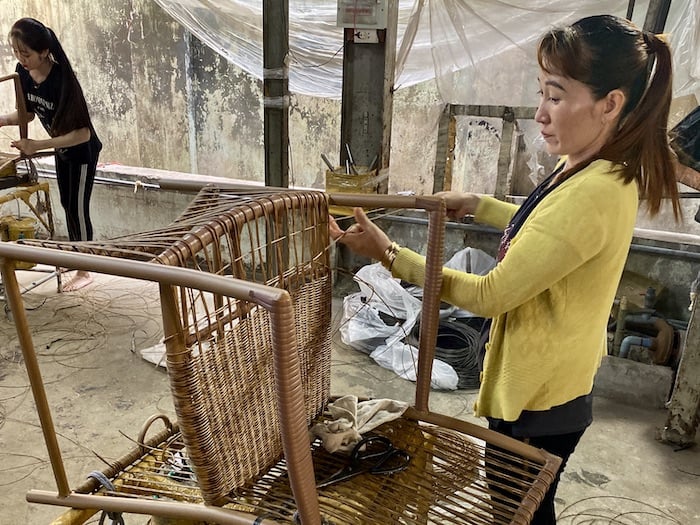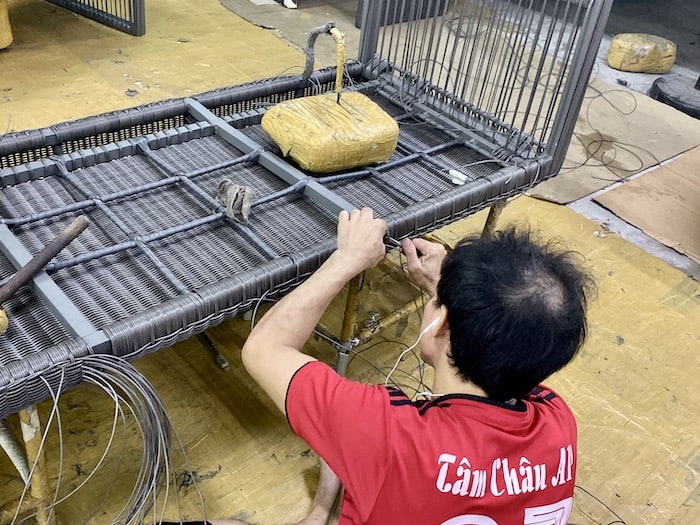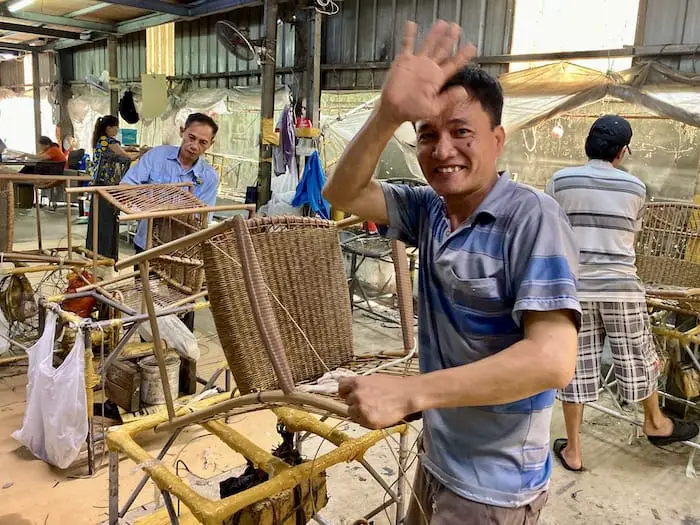Weaving faux rattan wicker is a production process done entirely by hand. Even today, when you go into a factory, you can see the workers weaving a piece of furniture entirely by hand.
Vietnam is a significant manufacturer and weaver of faux rattan furniture and other faux rattan items; Vietnam has readily available faux rattan materials and a highly skilled workforce that can weave complex faux rattan wicker furniture and other faux rattan items.
Table of Contents
- A quick history of furniture and basket wicker weaving
- What Is Wicker? Clearing Up The Definition
- Faux Rattan, what you need to know
- Frequently Asked Questions
- Related Questions
Weaving wicker products have a long and varied history. Yet, many people are confused between the definitions of rattan and wicker. Wicker is a type of weave, and rattan is a material used to weave furniture or baskets.

A quick history of furniture and basket wicker weaving
Woven furniture may, to many, seem like an invention of the Victorian era; the truth is that weaving and making furniture, baskets, and many other household items started thousands of years ago.
Weaving, particularly basket weaving, is one of the most widely distributed human skills worldwide. Almost everywhere you go, there is a history of some weaving.
It is tough to know how old the weaving skill is as baskets have been found dating back 10,000 or 12,000 years. It can be fair to say that from when the earth came to be, men and women have been taking some of the natural materials they have found and weaving them together to form objects, baskets, and furniture pieces.
King Tutankhamun (ca 1341-1323) was buried with a wicker chair seat and a headboard. The woven wicker furniture inspired the Romans, so they started their weaving techniques. And this continued to spread throughout Europe. In Holland, many old baby beds used wicker.
All of Asia has had some weaving traditions. Vietnam has many baskets and furniture-weaving villages where inhabitants have been weaving furniture, baskets, and other objects for thousands of years. These skills are usually passed down from father to son so that each generation will build upon the previous generation’s skill sets.
Tour With Us As We Visit A Faux Rattan Weaving Factory in Vietnam
(Click On the Video Link Below)
What Is Wicker? Clearing Up The Definition
I know that I have often been confused when people use the word “wicker.” Does that mean a kind of material? Can a faux rattan basket, chair, or lamp also be considered wicker?
The Oxford Dictionary defines wicker as:
“Pliable twigs, typically of willow, plaited or woven to make items such as furniture and baskets.
Oxford Dictionary
The dictionary explains that the word wicker is of Scandinavian origin with the Swedish word “viker” or willow, which is related to the Swedish word “Vika,” which means to bend. So, wicker is the process of bending materials to be woven into an object.
According to this definition, wicker is not a material but a type of weave. It is weaving or bending materials to form objects like a basket or chair.
This can get confusing for many people as they may see wicker as a kind of material. For years, I was also confused by this, and I thought wicker was a kind of material and not a weave. But according to the definition, wicker is a kind of weave. Therefore, you can have a wicker faux rattan chair, which would be a chair that uses faux rattan material with a wicker weave.
On the other hand, rattan is a material and not a weave. That is why sometimes you can hear things called a wicker rattan weave. This would be a woven object such as a chair or basket using rattan material.
Many people get this confused, and they may use the words wicker and rattan interchangeably, but the truth is that they are not the same thing. Wicker is a kind of weave, and rattan is a material used to weave wicker.

Faux Rattan, what you need to know
It is expected to be called faux rattan resin wicker or all-weather wicker rattan. Essentially, faux rattan is manufactured to withstand all kinds of weather, including cold winter weather.
Today, faux rattan materials continue to get more sophisticated and have started to look more and more like genuine rattan. In fact, for some materials, you have to look very closely to know if the rattan is faux or real.
With the improvement of the faux rattan, quality is also improved, with the materials being able to withstand the sun’s UV rays and water resistance. It continues to be treated and tested to withstand extreme heat and cold.
Vietnam’s faux rattan wicker weaving industry
Over the last 15 to 20 years, Vietnam has become a significant exporter and weaver of faux rattan wicker furniture. There are many reasons for this, including:
- Available materials – Today, it is much easier in Vietnam to get faux rattan materials than many of the more extensive natural rattan materials required for large-scale furniture production. This means many factories prefer or can only do faux rattan due to the materials.
- Color and size matching – With the availability of materials, many suppliers are now also happy to custom-make colors or even match your finish and size. We have special ordered some faux rattan in the size and color we wanted without any problem.
- Workers – The workers are now used to weaving with faux rattan materials. Even though faux rattan is usually heavier than weaving with natural rattan material, the workers are now used to weaving with faux rattan very quickly.
Watch this video to see how fast this factory worker is when weaving faux rattan onto this sofa set.
When you watch that video, you can see how highly skilled these faux rattan weavers are and how fast they can work. When we watched this worker weaving this sofa, we were in awe of how fast he could work.
Vietnam is your correct manufacturing choice for indoor or outdoor furniture in faux rattan, rope, or other woven materials. They have the raw materials and highly skilled workers. This means that they have a competitive advantage over other locations and places.
Find out more about how Mondoro can help you create, develop, and manufacture excellent home decor and furniture products – don’t hesitate to contact me, Anita. Check out my email by clicking here or become a part of our community and join our newsletter by clicking here.
Mondoro gives out a FREE Lookbook to anyone interested. You can receive a copy of our latest Lookbook by clicking here.
Listen to our Podcast called Global Trade Gal. You can find it on all major podcast platforms. Try out to listen to one of our podcasts by clicking here.
Subscribe to our Mondoro Company Limited YouTube Channel with great videos and information by clicking here.
Frequently Asked Questions
What is faux rattan weaving?
Faux rattan weaving is the process of creating furniture and items that mimic the appearance of natural rattan using synthetic materials. This process involves handweaving these materials to create intricate and durable designs.
Why is hand-weaving important in faux rattan production?
Hand-weaving is essential in faux rattan production because it allows for intricate designs and attention to detail. Skilled artisans can create unique patterns that give faux rattan furniture its distinct aesthetic appeal.
Why is Vietnam a significant player in faux rattan weaving?
Vietnam is a major faux rattan weaving hub due to its abundant supply of faux rattan materials and a skilled workforce with a long history of traditional weaving techniques.
What are the advantages of using faux rattan materials?
Faux rattan materials are often more durable and weather-resistant than natural rattan. They are also more versatile, as they can be shaped into various designs and are less susceptible to damage from moisture and pests.
How is the faux rattan weaving process carried out by hand in Vietnam?
Skilled artisans in Vietnam use manual weaving techniques to create faux rattan furniture. They carefully weave individual strands of synthetic material to form intricate patterns and designs.
What types of items are commonly hand-woven using faux rattan in Vietnam?
In Vietnam, faux rattan is used to create a wide range of products, including furniture such as chairs, tables, and sofas, as well as home decor items like baskets, lampshades, and planters.
What sets Vietnamese faux rattan weaving apart from other countries?
Vietnamese artisans are known for their attention to detail and ability to weave complex patterns. Their craftsmanship gives faux rattan products a unique and high-quality finish.
Is faux rattan weaving environmentally friendly?
Faux rattan weaving can be more environmentally friendly than using natural rattan because it reduces the demand for harvesting rattan from natural ecosystems. However, the environmental impact can vary depending on the materials used in the synthetic rattan.
Can faux rattan furniture be used outdoors?
Yes, faux rattan furniture is often designed to be used outdoors. Its synthetic materials are resistant to weathering, making it suitable for outdoor settings where natural rattan might deteriorate.
Related Questions
What is the difference between rattan and rattan effect?
Rattan is a natural material, and the rattan effect is also known as Faux Rattan, Resin Rattan, and All-Weather Rattan. Rattan is for items that will be indoors, whereas the rattan effect or faux rattan is all-weather and can be used outdoors or indoors.
What kind of care does faux rattan furniture need?
Most faux rattan furniture can be left outside, even in the winter months. But if you are going to leave them outside and exposed to very harsh winter elements, you should cover them with a PVC waterproof cloth.
Of course, to ensure your furniture will stay in top condition, it would be best to bring them inside to a garage or storage unit, especially if you live in a climate that has a lot of snow and very extreme winter weather.

